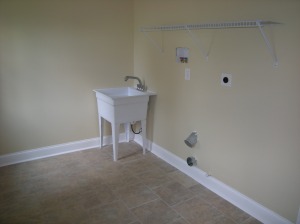Don’t wash those windows. Replace them! There are some real benefits to replacing windows in older homes, but like any home improvement project, there is a lot to consider.
We recently replaced all of our windows on our nearly hundred year old home. This story starts with windows that were single pane, drafty, and mostly painted shut. Storm windows had been added to these original windows sometime during the last 30 years, but that made them even harder or impossible to use and clean. Some of the windows also blocked egress in a fire, and that was a real problem for me. The last straw was when we noticed that the interior paint on the window nearest the baby’s crib was peeling worse than a bad sunburn at the shore.
We are not novices. We’ve replaced windows in all three of the vintage homes that we’ve owned. The first time, the choice was driven by function, and a quality vinyl window in our price range was just the ticket. The second time, we installed vinyl windows with our own hands in just a few rooms. But in our current home, we had specific requirements. Because we wanted to maintain the architectural integrity of the home, we were shopping for a certain style and caliber of window, and we knew that vinyl was not going to be the answer.
When you really start to investigate this market, you might be surprised at the range of options. Materials range from all wood with various types of cladding to composite products that may or may not contain wood. Styles vary widely, even within the same window type, and just the options for window grids (also known as grilles or mutton bars) or hardware can be overwhelming. Color options seem endless. And installation processes and providers are a whole different set of discussions. All of these options will vary the range of prices for a single window from $200 to nearly $2,000.
We chose to interview four top brands that were available in our area. Some of them had been recommendations through friends, and some of them were top names that we wanted to learn more about. We also researched the brands through Consumer Reports’ November 2009 report. We read online comparisons like those at http://www.windowhelpbook.com, which confirmed my suspicion that our payback was not going to be as high as we’d hoped. We visited showrooms and had vendors in to our home. If this sounds scary to you, get some help on how to hire a contractor.
Even Uncle Sam wants you to upgrade your view. Because the energy savings can be pretty good (I hesitate to say significant), you may be eligible for up to $1,500 in tax credits (this is different than a deduction) if you install qualifying purchases by the end of 2010. In fact, the typical energy savings for a whole-house replacement of windows hovers somewhere around 20% annually. It makes sense to do the math, so, let’s do the math.
| |
Current costs |
Reduction with new windows |
| Heating & Cooling costs annually |
$2,400 assumed |
~($480/year) |
| IRS energy tax credit through 2010 |
n/a |
($1500 max) |
| Cost of maintenance (painting existing window exterior) |
$2,000 every 5 years assumed |
$0, assumes maintenance free capping |
| Cost of touch-up painting, not included in typical installations |
n/a |
$500 |
| Average nationwide investment |
$0 |
$12K-$18,000 |
Using the numbers above, the payback period for the windows, before they start to pay for themselves in energy and maintenance savings, is somewhere between 19 and 35 years. I had to think about this as I was ripping out 100 year old windows!
The Hanley Wood Remodeling 2009/10 Cost vs Value report pegs ROI on replacement windows at somewhere around 77%. This is actually a pretty good ROI compared to other home projects, but it is also another way of saying that you would lose about 23% of your investment right away in a resale. This is a project you want to take on if you’ll be in your home a while or if your current windows would actually be an impediment to selling your home.
Like I said, this is not a slam dunk. It’s not as if your energy efficient windows are going to start saving you tons of money right away.
But wait…there’s more! Just this April, 2010, the new US Environmental Protection Agency (EPA) regulations kicked in regarding practices designed to minimize the exposure of lead hazards in homes built before 1978. If your home is one of these lucky ones, you can now expect to pay around another $150 per window for the training and standards that your contractor must follow to contain potential lead hazards. These include personal protective clothing for the installers, and extensive plastic tenting for containment of dust and debris, as well as cleaning protocols for your home. This isn’t optional, but mandatory for all contractors, and they face stiff fines if they disregard the new laws.
In the end, we did decide to replace our windows. Because we were doing straight replacements, meaning that we were using the original openings for all of the windows instead of increasing window openings, things were able to go rather quickly. We took the calculated risk of allowing the work to be done while we were away during a week, figuring this would be the easier way to do construction in a home with two small children. Even though we had a pre-install walk through and one full day when we were on-site at the start of construction, we were disappointed to come back to a full list of problems. They included capping that was done contrary to the work order, sloppy caulking, visible gaps in between the windows and the walls, broken hardware, and two casement windows that had been swapped, leaving them both to open in the wrong direction. Needless to say, we were disappointed.
What we did like, though, was the suggestion to include full screens on our double hung windows, allowing us to safely have the top sash open in rooms where children will be playing. The site was clean when we arrived home. The look of the windows is ideal. And our contractor immediately responded to our requests.
Although we’d like to imagine that every home improvement project gets done right, on time, and in budget, that’s not always the case. But the key is to keep the lines of communication open with your contractor, document the problems, specify in writing clear requests for repairs or completions, and most importantly, withhold half or more of the full payment until the work is completed to the terms of the original contract.
I hope to be able to append this post within a month or so with happy news about the final outcome of our window project. For now, we are happy that we can open our windows and enjoy the spring breezes. If you decide to set out to bring the outside in with new windows in your home, I hope that our experience and the resources found here will help you through.



















